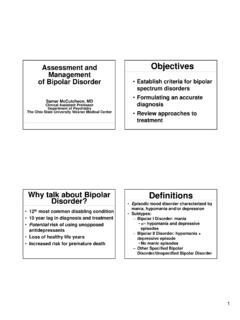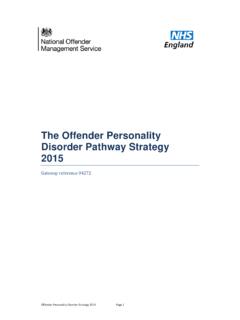Transcription of Approaches to Drug Abuse Counseling
1 ACKNOWLEDGMENTS This publication contains information on various drug Abuse Counseling Approaches , written by representatives of many well-known treatment programs. Although the Counseling Approaches included are used in some of the best known and most respected treatment programs in this country, it has not been determined whether all of these Counseling models are equally effective. These various Approaches are presented in an identical outline form so that the reader can compare and contrast the many treatment models described and learn more about the roles of the counselor and subject in a particular model. COPYRIGHT STATUS All material in this volume is in the public domain and may be used or reproduced without permission from the National Institute on Drug Abuse (NIDA) or the authors. Citation of the source is appreciated. DISCLAIMER Opinions expressed in this volume are those of the authors and do not necessarily reflect the opinions or official policy of NIDA or any other part of the Department of Health and Human Services.
2 The Government does not endorse or favor any specific commercial product or company. Trade, proprietary, or company names appearing in this publication are used only because they are considered essential in the context of the models reported herein. PUBLIC DOMAIN NOTICE All material appearing in this report is in the public domain and may be reproduced without permission from the National Institute on Drug Abuse or the authors. Citation of the source is appreciated. National Institute on Drug Abuse NIH Publication No. 00-4151 Printed July 2000 CONTENTS Introduction and Overview ..1 John J. Boren, Lisa Simon Onken, and Kathleen M. Carroll Dual disorders Recovery Counseling ..5 Dennis C. Daley The CENAPS Model of Relapse Prevention Therapy (CMRPT ) .. 23 Terence T. Gorski The Living In Balance Counseling Approach .. 39 Jeffrey A.
3 Hoffman, Ben Jones, Barry D. Caudill, Dale W. Mayo, and Kathleen A. Mack treatment of Dually Diagnosed Adolescents: The Individual Therapeutic Alliance Within a Day treatment Model .. 61 Elizabeth Driscoll Jorgensen and Richard Salwen Description of an Addiction Counseling Approach .. 81 Delinda Mercer Description of the Solution-Focused Brief Therapy Approach to Problem Drinking .. 91 Scott D. Miller Motivational Enhancement Therapy: Description of Counseling Approach .. 99 William R. Miller Twelve-Step Facilitation .. 107 Joseph Nowinski Minnesota Model: Description of Counseling Approach .. 117 Patricia Owen A Counseling Approach .. 127 Fred Sipe A Psychotherapeutic and Skills-Training Approach to the treatment of Drug Addiction .. 139 Arnold M. Washton iii Dual disorders Recovery Counseling Dennis C.
4 Daley 1. OVERVIEW, DESCRIPTION, AND RATIONALE General Description of Approach Dual disorders recovery Counseling (DDRC) is an integrated approach to treatment of patients with drug use disorders and comorbid psychiatric disorders . The DDRC model, which integrates individual and group addiction Counseling Approaches with psychiatric interventions, attempts to balance the focus of treatment so that both the patient s addiction and psychiatric issues are addressed. The DDRC model is based on the assumption that there are several treatment phases that patients may go through. These phases are rough guidelines delineating some typical issues patients deal with and include: Phase 1 Engagement and Stabilization. In this phase, patients are persuaded, motivated, or involuntarily committed to treatment . The main goal of this phase is to help stabilize the acute symptoms of the psychiatric illness and/or the drug use disorder.
5 Another important goal is to motivate patients to continue in treatment once the acute crisis is stabilized or the involuntary commitment expires. Dealing with ambivalence regarding recovery, working through denial of either or both illnesses, and becoming motivated for continued care are other important goals during this phase. This phase usually takes several weeks, but for some patients it takes longer to become engaged in recovery and to stabilize from acute effects of their dual disorders . Phase 2 Early Recovery. This phase involves learning to cope with desires to use chemicals; avoiding or coping with people, places, and things that represent high-risk addiction relapse factors; learning to cope with psychiatric symptoms; getting involved in support groups, such as Alcoholics Anonymous (AA), Narcotics Anonymous (NA), Cocaine Anonymous (CA), Rational Recovery (RR), Dual Recovery Anonymous, or mental health support groups; getting the family involved (if indicated); beginning to build structure into life; and identifying problems to work on in recovery.
6 This phase roughly involves the first 3 months following stabilization. However, some patients take much longer in this phase because they do not comply with treatment , continue to Abuse drugs, experience exacerbations of psychiatric symptomology, or experience serious psychosocial problems or crises. Phase 3 Middle Recovery. In this phase, patients continue working on issues from the previous phase as needed. In addition, patients learn to develop or improve coping skills to deal with intrapersonal and interpersonal issues. Examples of intrapersonal skills include coping with negative affect (anger, depression, emptiness, anxiety) and coping with maladaptive beliefs or thinking. Interpersonal issues that may be addressed during this phase include making amends, improving communication or relationship skills, and further developing social and recovery support systems.
7 This phase also focuses on helping patients cope with persistent symptoms of psychiatric illness; drug use lapses, relapses, or setbacks; and crises related to the psychiatric disorder. It also focuses on helping identify and 5 manage relapse warning signs and high-risk relapse factors related to either illness. The middle recovery phase involves months 4 through 12, although some patients never get much beyond early recovery even after a long time in treatment . Patients who are treated for an initial acute episode of psychiatric illness with pharmacotherapy in addition to DDRC and who do not have a recurrent or persistent mental illness may be tapered off medications during this phase. Patients are usually not tapered off medications until they have several months or longer of significant improvement in psychiatric symptomology. Phase 4 Late Recovery.
8 This phase, also referred to as the maintenance phase of recovery, involves continued work on issues addressed in the middle phase of recovery and work on other clinical issues that emerge. Important intrapersonal or interpersonal issues may be explored in greater depth during this phase for patients who have continued abstinence and remained relatively free of major psychiatric symptoms. This phase continues beyond year 1. Many patients with chronic or persistent forms of psychiatric illness ( , schizophrenia, bipolar disease, recurrent major depression), or severe personality disorders such as borderline personality disorder, often continue active involvement in treatment . treatment during this phase may involve maintenance pharmacotherapy, supportive DDRC Counseling , or some specific form of psychotherapy ( , interpersonal psychotherapy).
9 Involvement in support groups continues during this phase of recovery as well. Goals and Objectives of Approach The goals of this Counseling model are: 1. Achieving and maintaining abstinence from alcohol or other drugs of Abuse or, for patients unable or unwilling to work toward total abstinence, reducing the amount and frequency of use and concomitant biopsychosocial sequelae associated with drug use disorders . 2. Stabilizing acute psychiatric symptoms. 3. Resolving or reducing problems and improving physical, emotional, social, family, interpersonal, occupational, academic, spiritual, financial, and legal functioning. 4. Working toward positive lifestyle change. 5. Early intervention in the process of relapse to either the addiction or the psychiatric disorder. Theoretical Rationale/Mechanism of Action The DDRC Counseling approach involves a broad range of interventions: 1.
10 Motivating patients to seek detoxification or inpatient treatment if symptoms warrant, and sometimes facilitating an involuntary commitment for psychiatric care. 2. Educating patients about psychiatric illness, addictive illness, treatment , and the recovery process. 3. Supporting patients efforts at recovery and providing a sense of hope regarding positive change. 4. Referring patients for other needed services (case management, medical, social, vocational, economic needs). 5. Helping patients increase self-awareness so that information regarding dual disorders can be personalized. 6. Helping patients identify problems and areas of change. 6 7. 8. Helping patients develop and improve problemsolving ability and develop recovery coping skills. Facilitating pharmacotherapy evaluation and compliance. (This requires close collaboration with the team psychiatrist.)









